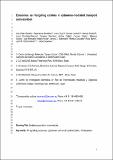Files in this item
Exosomes as Hedgehog carriers in cytoneme-mediated transport and secretion
Item metadata
| dc.contributor.author | Gradilla, Ana-Citlali | |
| dc.contributor.author | González, Esperanza | |
| dc.contributor.author | Seijo, Irene | |
| dc.contributor.author | Andrés, German | |
| dc.contributor.author | Bischoff, Marcus | |
| dc.contributor.author | González-Mendez, Laura | |
| dc.contributor.author | Sánchez, Vanessa | |
| dc.contributor.author | Callejo, Ainhoa | |
| dc.contributor.author | Ibáñez, Carmen | |
| dc.contributor.author | Guerra, Milagros | |
| dc.contributor.author | Ortigão-Farias, João Ramalho | |
| dc.contributor.author | Sutherland, James D | |
| dc.contributor.author | González, Monika | |
| dc.contributor.author | Barrio, Rosa | |
| dc.contributor.author | Falcón-Pérez, Juan M | |
| dc.contributor.author | Guerrero, Isabel | |
| dc.date.accessioned | 2017-11-30T15:30:05Z | |
| dc.date.available | 2017-11-30T15:30:05Z | |
| dc.date.issued | 2014-12-04 | |
| dc.identifier | 159051153 | |
| dc.identifier | 2ce19d3e-190a-4c9c-b580-e7a294463198 | |
| dc.identifier | 25472772 | |
| dc.identifier | 84922846700 | |
| dc.identifier | 000347227400003 | |
| dc.identifier.citation | Gradilla , A-C , González , E , Seijo , I , Andrés , G , Bischoff , M , González-Mendez , L , Sánchez , V , Callejo , A , Ibáñez , C , Guerra , M , Ortigão-Farias , J R , Sutherland , J D , González , M , Barrio , R , Falcón-Pérez , J M & Guerrero , I 2014 , ' Exosomes as Hedgehog carriers in cytoneme-mediated transport and secretion ' , Nature Communications , vol. 5 , 5649 . https://doi.org/10.1038/ncomms6649 | en |
| dc.identifier.issn | 2041-1723 | |
| dc.identifier.other | ORCID: /0000-0002-0737-6321/work/41120263 | |
| dc.identifier.uri | https://hdl.handle.net/10023/12211 | |
| dc.description.abstract | The Hedgehog signalling pathway is crucial for development, adult stem cell maintenance, cell migration and axon guidance in a wide range of organisms. During development, the Hh morphogen directs tissue patterning according to a concentration gradient. Lipid modifications on Hh are needed to achieve graded distribution, leading to debate about how Hh is transported to target cells despite being membrane-tethered. Cytonemes in the region of Hh signalling have been shown to be essential for gradient formation, but the carrier of the morphogen is yet to be defined. Here we show that Hh and its co-receptor Ihog are in exovesicles transported via cytonemes. These exovesicles present protein markers and other features of exosomes. Moreover, the cell machinery for exosome formation is necessary for normal Hh secretion and graded signalling. We propose Hh transport via exosomes along cytonemes as a significant mechanism for the restricted distribution of a lipid-modified morphogen. | |
| dc.format.extent | 13 | |
| dc.format.extent | 1528162 | |
| dc.language.iso | eng | |
| dc.relation.ispartof | Nature Communications | en |
| dc.subject | Hh signalling | en |
| dc.subject | Exosomes | en |
| dc.subject | Cytonemes | en |
| dc.subject | Cell-to-cell communication | en |
| dc.subject | Hh dispersion | en |
| dc.subject | QH301 Biology | en |
| dc.subject | BDC | en |
| dc.subject | R2C | en |
| dc.subject.lcc | QH301 | en |
| dc.title | Exosomes as Hedgehog carriers in cytoneme-mediated transport and secretion | en |
| dc.type | Journal article | en |
| dc.contributor.institution | University of St Andrews. School of Biology | en |
| dc.contributor.institution | University of St Andrews. Biomedical Sciences Research Complex | en |
| dc.identifier.doi | 10.1038/ncomms6649 | |
| dc.description.status | Peer reviewed | en |
This item appears in the following Collection(s)
Items in the St Andrews Research Repository are protected by copyright, with all rights reserved, unless otherwise indicated.

